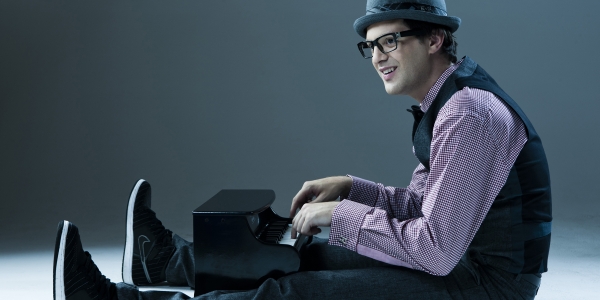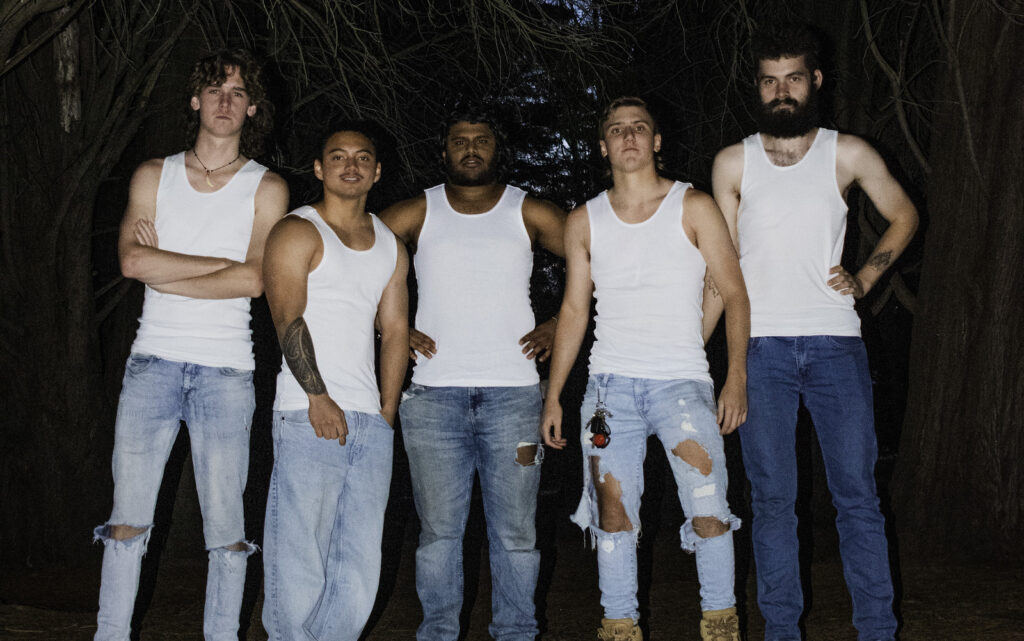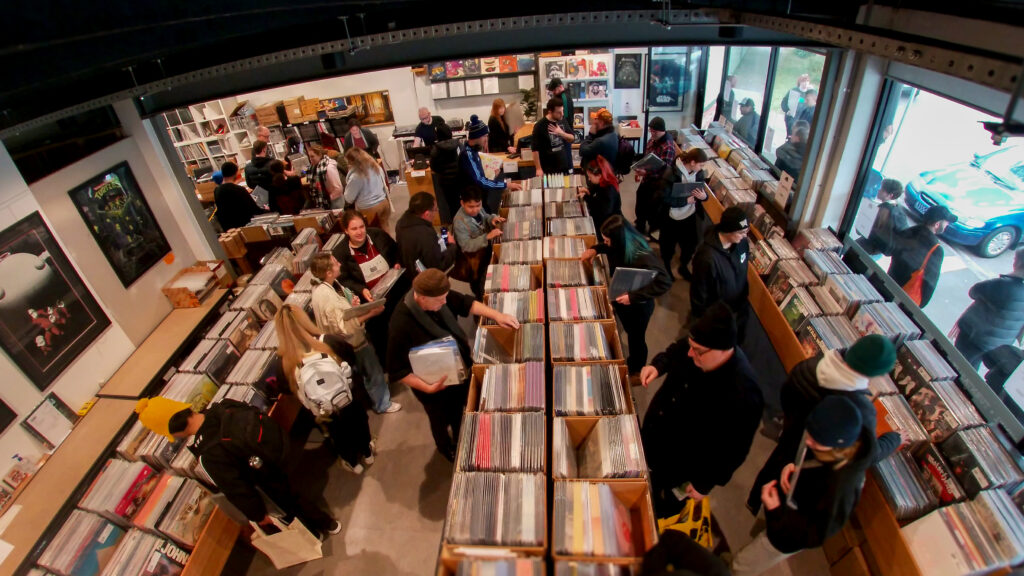In the GQ piece, Hawthorne named everyone from Marvin Gaye – the ultimate ladies man – and James Brown to Eric B and Rakim as influences on his flashy but classy aesthetic. For him, sartorial elegance is not just something for the stage and photo shoots – it’s a lifelong pursuit. “Dressing well is just part of everyday life for me,” he says, when I ask about his love of looking snappy. “Even when you go to the record store, you’ve gotta keep it classy. That’s just my personal style, though. That’s what makes me feel good. To each his own, you know? Whatever makes you feel good, that’s the way you’ve gotta rock it.”
Hawthorne’s love of soul music dates all the way back to his childhood. Born and raised in Michigan, he grew up immersed in the Motown sound, and in fact, his favourite pastime as a child was listening to 45s on his Fisher Price record player. His nickname, Haircut, dates back to this period. “When I was a toddler, I absolutely hated to get my hair cut,” he tells me with a laugh. “I would have tantrums, man – I was a total baby about it! My parents would buy me 45s to keep me occupied while I got a trim, and that was the only thing that worked. All I ever wanted to do was play records,” he says. “My folks still call me ‘Haircut’ to this day.”
While Hawthorne had always loved soul music, he didn’t consider a career as a soul musician until later in the piece – in fact, his first musical forays were as a hip hop producer and DJ. The only reason he started making soul was to have a cheap and easy source of samples for the rap songs he was producing. “A lot of the deep knowledge I have of soul music actually came through hip hop and from digging for all the samples in my favourite rap songs. When I moved to LA, I wanted to make rap music, not soul, but I was getting sued for some of the samples that I’d used, and I decided, well, I don’t want to pay anybody for clearance, I don’t want to be involved I these crazy lawsuits all the time, so I’ll just make my own samples! That’s really how it started, out of necessity, really.”
It took a while for it to click into place that this was what Hawthorne wanted to do with his life. “It really didn’t really happen until I had started really touring around and doing a lot of shows,” he tells me. “We did some big festivals out here. Definitely a big moment for me was Bonnaroo Festival here in the States. We had the ill 10pm time slot, there were 15,000 people out there in the crowd, and I just remember thinking, ‘Wow, I really could do this for the rest of my life’. It took a while, you know? There was definitely a period when I thought, ‘This is cool but I’m definitely going to go back to making hip hop music and being a DJ’. I originally thought of this as just a side project, and that I’d just sell 1000 copies and then go back to the rap thing.”
Hawthorne’s breakthrough record, How Do You Do?, came out last year to great acclaim and cemented his transition from hip hop beat-maker to bona fide soul crooner. Drenched in hooks and with strut to spare, its 12 tracks harked back effortlessly to eras gone by. The Walk, which could have come directly from the ‘60s, was a defiant kiss-off to an old lover while Hooked, with its classic brass, was pure Motown joy. Finally, Falling harked back to the white-boy soul of You Make My Dreams hit-makers Hall & Oates, two more people that Hawthorne cited as style icons. One of the album’s more surreal moments, however, is Can’t Stop, which features a guest spot from none other than Snoop Dogg.
Now, objectively speaking, you know you’ve made it in pop music when Snoop Dogg shows up to do a cameo on one of your records. Both Katy Perry and Robyn have experienced this in recent years, but in both of those cases, Snoop was rapping. On Can’t Stop, listeners get the extremely rare pleasure of hearing him sing. How did Hawthorne possibly hook such a thing up, I ask? “That was easy,” he says, laughing. “I’d done some remixes for him before, and Snoop and I share a common love for classic soul. He’s always bumping The Dramatics, The Chi-Lites, Willie Hutch, all that good stuff, and he’s always singing along! He asked what he had to do to get on my album, and I said, ‘You gotta sing!’”
Although he has set the collaborations bar pretty high with Snoop, I ask Hawthorne if there are any other artists he’d like to work with in the future, anyone who might tickle his fancy or add just the right lovelorn note to one of his ballads. “I want to work with anyone who is doing different and creative things,” he says, “people who are moving the music forward. I just got out of a session with Pharrell [Williams]. That was crazy. I learned a lot. I would love to work with Benny Sings from Holland. Some of my fans might be surprised to hear it, but I think Justin Timberlake is brilliant.”
There’s a certain continuity between How Do You Do? and Mark Ronson’s productions, especially some of the tracks on Record Collection – both fuse soul music with hip hop beats, and both share that unbridled sense of happiness and enthusiasm. I ask Hawthorne if he’d ever consider working with Ronson – or indeed, if a collaboration has been suggested at any point – and he says he’d definitely think about it. “Mark Ronson was the first DJ to play my music on the radio,” Hawthorne tells me, “and I’ll always sincerely love him for that. He definitely has good taste in music!”
Given the warm, vintage sound of How Do You Do?, I ask Hawthorne if he’s one of those musicians, like Jack White, who favours vintage recording techniques, and has to work in a studio full of analogue gear. “Oh no,” he says with a chuckle, “I’m definitely not one of those guys that’s like, ‘Oh, everything has to be analogue equipment and I have to record directly to vinyl’. I’m not one of those guys at all.” As Hawthorne sees it, he lives in 2012, so he should therefore take advantage of as much modern technology as possible.
“A lot of people think that I live in some sort of vintage world where I only listen to Otis Redding in vinyl and I shun technology, but that’s not the case,” he continues. “I’m a young dude – I have an iPhone! Why wouldn’t you take advantage of all the technology that’s available? You’d be crazy not to. Obviously, I want to get that warm sound, but there are other ways you can do that.” So it doesn’t have to be painstaking, I venture? “Right, exactly,” he says. “It doesn’t have to be painstaking for it to work!”
After listening to How Do You Do?, the one thing you come away with is the sense of pure joy that the music exudes, especially tracks like Hooked, which is two and a half minutes of sunny day distilled into music. I ask Hawthorne if he is consciously trying to evoke this feeling with the music, and he says yes. “Fun is number one, man,” he says. “That’s the motto around here, and I think that’s one of the main reasons that so many people are drawn to this music. That’s the only rule that I have when I’m making music, is that it has to be fun. Everybody wants to have fun.”
Given the explosive acclaim for How Do You Do?, the greatest priority for Mayer Hawthorne right now is just keeping his feet on the ground. “Oh man, you know, I’m just doing my regular thing, you know?” he says coyly, when I ask how he’s surviving the hype. “I’m still the same old me. I’ve just been doing my best to try and ride the wave, making sure I wake up every morning. I’m thankful for this opportunity I’ve been given to make music for a living, to do what I love for a living. Above all, I just make sure that I don’t take it for granted.”
BY ALASDAIR DUNCAN







